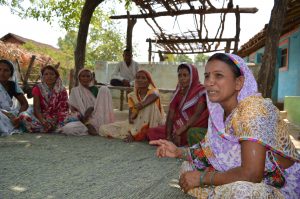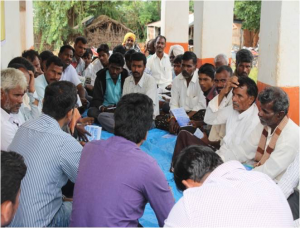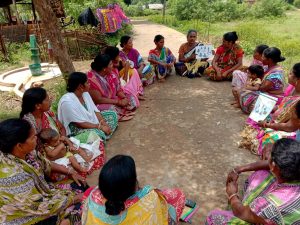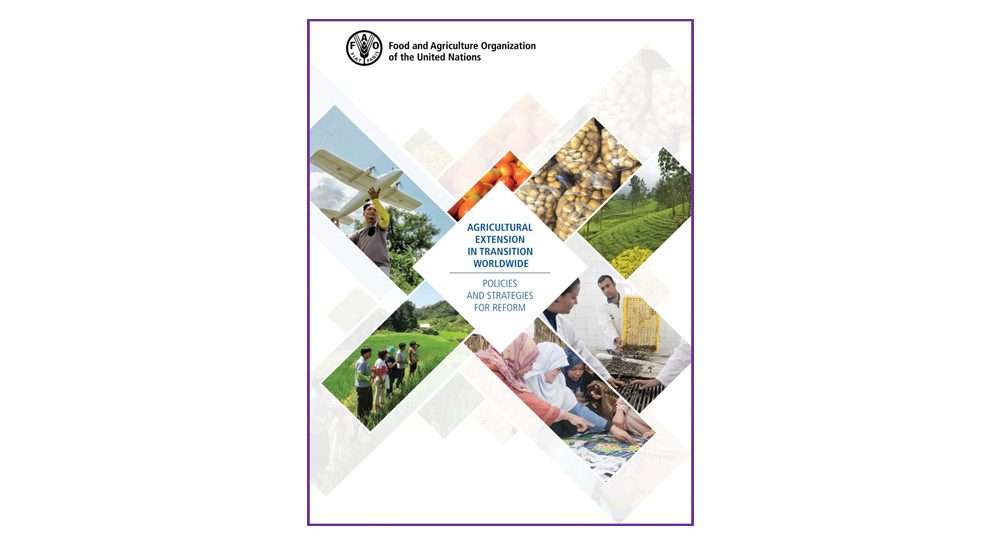Blum ML, Cofini F and Sulaiman VR.
Edited by Lawrence T. FAO. (2020)
ISBN: 978-92-5-132294-9
Downloadable at:
http://www.fao.org/3/ca8199en/CA8199EN.pdf
Pages 252
Agricultural Extension Services – increasingly known as Extension and Advisory Services (EAS) or as Rural Advisory Services (RAS) – have evolved considerably during the past few decades. This new publication from the Food and Agricultural Organisation of the United Nations (FAO) reviews the changing context of EAS and reflects on the performance of reforms that were implemented to improve the performance of EAS. It contains 12 modules, and each module commences with objectives, and then goes on to clarification of concepts, a discussion on the theme, and presentation of case studies. In addition, each module has a summary, tools, and concludes with an exercise for the readers.
Trends in Extension Reform
The most remarkable shifts have come about thus: i) from provision of advisory services by a single public sector-financed organisation to multiple advisory service providers with multiple funding sources; ii) from a standard one-size-fits model to country-specific models; iii) from centralized to decentralized public system; and iv) from focus on technology and enhancing agricultural production to addressing a wide range of problems faced by farmers, which includes natural resource management, marketing, adaptation to climate change, nutrition, etc. Many of these need collective action by farmers as well as co-ordinated efforts by various agencies.
The drivers of change that forced extension reforms include: the changing nature of agriculture, the inability of the public sector extension system to effectively address the needs of smallholder families, and emergence of demand-led and market-oriented advisory systems. There is an increasing realisation that, in addition to promoting technology, EAS must help farmers to: i) better understand the market and link them effectively to markets; ii) reduce their vulnerability and enhance their voice; iii) promote environmental conservation; iv) support smallholders in adapting their production to climate change and make their livelihoods more resilient, etc.
The Global Forum for Agricultural Advisory Service (GFRAS) categorised the extended role of Extension into three broad areas, viz., Technology and information sharing, Advice on farm and business management, and Facilitation of value chains and rural development. The authors emphasize the need for EAS managers to recognize the diversity of actors in extension and realize the potential in fostering partnerships, and developing strong linkages between various actors/institutions in agriculture and rural development. Cases on the development of extension policy guidelines in Kenya, Bangladesh and Uganda are also provided.
Pluralistic Service Systems
Though having multiple service providers (public, private, NGOs and producer organisations) encourage competition and thereby improve their effectiveness and efficiency in providing services, the evidence brought out some crucial issues which must be addressed by the EAS. These include: i) limited capacity among many actors, poor coordination among actors, and lack of accountability to farmers; ii) willingness of farmers, including the resource-poor, to pay for the services that they value; and iii) availability of limited information on service provision, that too by the public sector agencies.
The emergence of pluralistic advisory services has posed many challenges, such as
- Effective and efficient delivery of EAS among different stakeholders is a challenge;
- How to make such diverse service providers accountable to the farmers? Promoting accountability means control on resources and services provided by EAS to farmers; and
- How to achieve functional coordination among them.
The authors highlight the role of Country Forums (promoted by the Regional Networks of GFRAS) which are made up of several stakeholder platforms at the country level that enable EAS actors to relate to each other within the framework of a set of fixed principles, roles and responsibilities.
The farmers are not aware of the different service providers, services and costs, which pose a serious problem for them in choosing the appropriate service provider. Hence, the authors suggest that a roster be prepared showing all the service providers, including privately-funded EAS programmes, to enable formulation of a national policy on service provision in agriculture and rural development.
Demand-driven EAS Systems and Services
 The development and growth of pluralistic extension services changed the role of farmers from passive information receivers to proactive information seekers. The authors present a framework for promoting demand-driven EAS. In demand-driven EAS Systems, services are impelled by user demand; service providers are accountable to the users who have an option to choose a service provider of their choice.
The development and growth of pluralistic extension services changed the role of farmers from passive information receivers to proactive information seekers. The authors present a framework for promoting demand-driven EAS. In demand-driven EAS Systems, services are impelled by user demand; service providers are accountable to the users who have an option to choose a service provider of their choice.
The transition from the government controlled and financed services to demand-driven services require commitment from the government. This also necessitates the establishment of institutional arrangements that strengthen the capacity of the service providers including POs (such as cooperatives, FPOs, etc.), and private players. The authors suggest five basic steps for developing demand-driven EAS: i) formulation of demand among farmers; ii) dialogue and negotiations with service providers; iii) preparation of services; iv) provision of services; and v) evaluation of the services received.
Linking Farmers to Markets
Linking farmers to markets through linking production activities to market demand is a challenge for the EAS. These linkages could be farmer to local trader (commission agent), farmer to retailer,
farmers to cooperatives, farmers or their organizations to agro-processor; farmers or their organizations to exporter and contract farming.
The ignorance of small holders on producing goods that meet the stringent quality standards of markets, lack of market information, and domination by middlemen make them victims of all types of malpractices, especially in weighing and price fixing. This compels extension professionals to develop their competency not only in ‘how to produce’ but also in ‘how to market’ agricultural commodities. There must be a shift in systems – from ‘technology-driven extension’ to ‘market-driven extension’. There is enough evidence to show that if small farmers organised themselves into viable and effective producer organisations (POs) they will be greatly helped in addressing market challenges. In certain cases, strengthening the market chain is a good option whereas in other situations, developing an alternative chain plays a vital role in helping farmers.
The prerequisite for this shift is that both farmers and extension service providers must have better access to reliable and up-to-date market information. However, access to market information is necessary but not enough for small farmers to effectively operate in markets. Hence, the focus must also be on developing a comprehensive Market-Oriented Advisory Services (MOASS) by the public sector extension system.
Financing Mechanisms for Pluralistic Demand-led RAS Systems
The availability and allocation of financial resources are critical factors determining the performance of EAS. Evidence has shown that when farmers or farmer organizations (being the users of services) pay for services they will be more empowered in negotiating their demand for services, and moreover, make service providers accountable to them and not to the government. In addition demand-led pluralistic extension services offer scope for provision of a new set of services for increased competitiveness and improved market linkages, etc.

Demand-led services imply the following: i) farmers desire to purchase services; ii) their ability to pay for the services; and iii) their willingness to pay for the services. Equally important is the price at which these services are available to the farmers which determine the quantity of the services demanded (the Law of Demand). But this transition to demand-led services calls for commitment from the government, service providers, and farmers organizations as the cost recovery for services from the farmers becomes an important factor. Three interesting case studies are presented in this module.
Role of Public Actors in EAS Governance and Service Provision
Provision of EAS has been decentralised and privatised in many countries. The transfer of financial responsibility is an important component of decentralization. In many countries, such as United States of America, China, Indonesia, Korea, Kenya, Canada, Germany, Brazil, India, Republic of South Africa, etc., EAS were decentralised with varying degrees of performance.
Public funding is important for extension as it has to provide services to resource-poor farmers, disadvantaged groups, and farmers in remote areas where many private sector service providers hesitate to provide services. Even in countries like New Zealand, England and Wales, and The Netherlands where the extension services are totally privatised, the national governments are subsidising it indirectly by employing private service providers to meet broad public interests, such as environment and food safety-related services. It appears that privatisation of EAS is helping farmers in many developed countries. The apple growers in Italy are paying for the excellent services provided by both cooperative and private service providers. In Denmark, DAAS which has thousands of small scale producers as members is paying for the salaries of the private advisors. Experiences from a few other countries such as Brazil, Chile and Mexico are not encouraging, and are undergoing several changes that should improve the system.
As the World Bank (2000) stated, centralization and decentralization are not ‘either-or’ conditions. Each country has a unique set of conditions, needs and challenges that affect what type of decentralization should be implemented. In practice, all services do not need to be decentralized in the same way or to the same degree. The authors are of the view that before decentralizing extension services, it would be useful to assess and support the preparedness of officials at lower levels of government and leaders at the institutional level to accommodate new planning and fiscal responsibilities.
Role of ICTs in EAS
Several ICT projects across the globe showed evidence on providing cost effective information services to various sections of society, including farmers. Because of these advantages private enterprises, donors, and national governments have started investing in deployment of ICTs for agriculture and rural development. Today, the use of mobile phones to access information pertaining to weather reports, market information, expert opinions on problems, etc., has become so common that it becomes difficult for many people to imagine life without mobile phones.
Despite these advantages, the ICTs are not free from criticism, namely, does the information disseminated through ICTs reflect the information needs and demands of the diverse categories of family farms, or more specifically of women and youth; and the dubious claims on sustainability, scalability and impact of several ICT projects. Hence, it is necessary to undertake research to: i) study and understand the developmental and empowerment implications of ICTs; ii) assess the contribution of ICTs in agriculture and rural development; and iii) study its contribution in empowering the rural poor.
Role of Producer Organisations (POs) in EAS
POs are playing a crucial role in providing market access to the producers in many countries. To realise the potential of POs in providing the varied services demanded by the producers, EAS should support the development of leadership, along with the organizational and management skills of key personnel/leaders of POs. This is also an area where EAS should enhance their capacities.
The EAS in many countries face challenges in facilitating the formation and strengthening of POs. These challenges revolve around inclusion of weaker sections or non-participating members in the activities of the POs; facilitation of the organizational development process for enhancing the capacities of POs and EAS; mobilisation of internal resources by enhancing the membership base and efficient use of external and internal resources; and empowering the members to develop the attitude of seeing the POs as their own.
 GFRAS (2015) made several recommendations with regard to fulfilling their roles in supplying and demanding EAS. In a similar vein, the FAO also suggested that the governments must strengthen the POs by involving them in agriculture policy development, the research institutions in setting the research agenda, and the POs must thrive well in securing greater autonomy and self-reliance in management of human and capital resources.
GFRAS (2015) made several recommendations with regard to fulfilling their roles in supplying and demanding EAS. In a similar vein, the FAO also suggested that the governments must strengthen the POs by involving them in agriculture policy development, the research institutions in setting the research agenda, and the POs must thrive well in securing greater autonomy and self-reliance in management of human and capital resources.
A Gender-sensitive EAS
Reducing gender inequalities in access and control of resources and services is considered to be an important pathway to improve agricultural production in developing countries. The authors provide several suggestions on how EAS can help in reducing gender gaps. Gender sensitive project designs are considered as entry points for promoting equitable participation of men and women in project activities. Both genders must be involved in all the project activities including evaluation and feedback. The selection of interventions must be based on a proper gender analysis which is necessary to understand the activity profile, gender relations, access to and control of resources, and their involvement in decision making.
Also advocated is the need to shift the focus from increasing production and productivity to improving income together with more productive employment opportunities for both men and women. It is advisable to make multiple services accessible and affordable to women. It is very important to empower them by promoting and strengthening women’s producers’ groups in various sectors of agriculture. EAS must be gender sensitive in terms of their policies and culture. This could be achieved by promoting gender balance in recruitment, career development in EAS, organizing capacity development programmes, developing a gender-sensitive organizational culture, and gender responsive budgeting. A few successful programmes to empower women are presented here.
Extension and Advisory Approaches and Methods
EAS needs to adopt new approaches and methods to deliver service effectively. The authors describe the manner in which extension approaches have changed over the years – from that of an information provider and educator to that of a facilitator who helps in accessing information and promoting innovation. Some of the important principles which guide the use of advisory methods are: encouraging clients’ participation at all stages of implementation, strengthening their capacity to demand services, acknowledging the value of local knowledge, encouraging and enabling them to make their own decisions.
Two case studies are presented as examples of matching advisory objectives with the specific needs of the target group. One is on the use of targeted methods to provide RAS to cocoa producers in five West African countries, and the other is on using multiple tools to provide services to promote nutrition-sensitive agriculture in Ethiopia. These two demonstrated the importance of selecting tools to address the specific needs of the producers clearly avoiding the ‘one size fits all’ syndrome.
Managing EAS Systems and Organizations
EAS organizations must act in an innovative and flexible manner to respond to the changing demand for a variety of services needed by diverse small farmers which necessitates change in their style of management as well as strengthening the managerial and leadership capabilities. They should have an appropriate legal framework, adequate financial support, credible and effective leadership and professionally well-qualified staff. The authors suggest that EAS organizations adopt Result Based Management (RBM) which provides scope for the managers and other stakeholders to improve their learning and accountability.
 Many countries are unable to conduct impact assessments of the EAS programmes owing to a lack of professional expertise, leadership and resources. Hence, the necessity to improve the skills of EAS managers in areas such as community mobilization, conflict management, problem solving, education and human development. Ideally, the capacity of the EAS needs to be enhanced and skills upgraded to effectively manage its systems and to ensure its financial and institutional sustainability.
Many countries are unable to conduct impact assessments of the EAS programmes owing to a lack of professional expertise, leadership and resources. Hence, the necessity to improve the skills of EAS managers in areas such as community mobilization, conflict management, problem solving, education and human development. Ideally, the capacity of the EAS needs to be enhanced and skills upgraded to effectively manage its systems and to ensure its financial and institutional sustainability.
EAS in Agricultural innovation System (AIS)
The AIS framework recognizes the necessity to promote collaboration and knowledge exchange among the various actors in the AIS to generate, adapt and use new knowledge. EAS are integral to the AIS. The AIS framework offers three potential insights on reforming EAS. First, it allows the role and organization of EAS to be understood as part of a wider canvas of actors, processes, institutions and policies that are critical for innovation. As EAS is only one of the major actors in the AIS, its comparative advantage lies in its transformation into become a ‘bridging’ organization, linking the different elements of knowledge held by different actors, and facilitating its application and use, thereby leading to innovation. This essentially means it has to interact and partner with a wide range of organizations dealing not only with markets, policy, financing, etc., but also with increasingly diverse sources of knowledge. Second, it forces EAS to change its approaches and expand its functions beyond dissemination of information and technologies, raising awareness and training. The experience suggests these kinds of traditional extension tasks have value only when bundled together with other innovation management tasks such as development of networks, organizing producers, communicating research needs, mediating conflicts, facilitating access to inputs and output services, convening innovation platforms, advocacy for policy change and other negotiated changes in practice and action. Third, the innovation systems framework emphasizes the need for promoting learning-based strategies to design locally-relevant arrangements. Till recently, most extension programmes were designed at the national or state level, and were implemented as targets to be achieved. Therefore, staff at the lower level had almost no freedom to experiment with locally-relevant strategies, or to reply to demands expressed by producers and to learn from these experiences.
Despite its advantages, the potential of AIS is not exploited in many countries to address complex agricultural problems. The main reason was that projects employing AIS have failed to convince donors of its robustness in supporting developmental efforts that can thus contribute towards making a difference at scale.
The authors Magdalena Blum, Francesca Cofini and V Rasheed Sulaiman together with the editor Lawrence T, need to be complimented for bringing out this valuable publication. It serves a useful purpose, especially for all those who wish to improve the effectiveness and efficiency of EAS.
Senior managers in extension organisations can benefit from the different case studies presented at the end of each module as these can help them to learn from these experiences of implementing extension reforms in many countries. The contents presented in the book will greatly help trainers who are designing training programmes for senior extension managers. In my opinion this book should be included as compulsory reading material for students pursuing higher education in extension at the Master’s and PhD level.
One of the shortcomings I noticed in this book is the repetition of some content in different modules. This could perhaps be due to the modular nature of the publication where the authors expect users to take interest only in a few of the relevant modules relating to their specific interests.
Albert Einstein said, “Problems cannot be solved by the same level of thinking that created them.” In keeping with that it is necessary to upgrade the competency of all the actors involved in the EAS system to help them better address the new challenges.
Prof. SVN Rao
 Dr SVN Rao retired as Professor and Head, Department of Veterinary and Animal Husbandry Extension Education, Rajiv Gandhi Institute of Veterinary Education and Research (RIVER), Puducherry. He can be contacted at: svnrao1953@gmail.com
Dr SVN Rao retired as Professor and Head, Department of Veterinary and Animal Husbandry Extension Education, Rajiv Gandhi Institute of Veterinary Education and Research (RIVER), Puducherry. He can be contacted at: svnrao1953@gmail.com





Add Comment